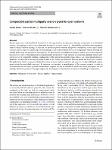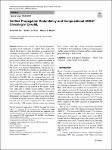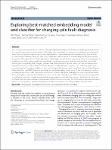Search
Author
- Jorgensen, Ed (3)
- McFadyen, Ron (3)
- Nora, El-Rashidy (3)
- Christian, Homeyer (2)
- next >
Subject
- programming (10)
- Open Access (8)
- Java (7)
- Programming (7)
- next >
Date issued
- 2020 - 2025 (293)
- 2010 - 2019 (39)
- 2000 - 2009 (2)
- 1999 - 1999 (1)
Has File(s)
- true (335)
Search Results
Crowd counting provides an important foundation for public security and urban management. Due to the existence of small targets and large density variations in crowd images, crowd counting is a challenging task. Mainstream methods usually apply convolution neural networks (CNNs) to regress a density map, which requires annotations of individual persons and counts. Weakly-supervised methods can avoid detailed labeling and only require counts as annotations of images, but existing methods fail to achieve satisfactory performance because a global perspective field and multi-level information are usually ignored. We propose a weakly-supervised method, DTCC, which effectively combines multi-level dilated convolution and transformer methods to realize end-to-end crowd counting. |
Session types are a well-established framework for the specification of interactions between components of a distributed systems. An important issue is how to determine the type for an open system, i.e., obtained by assembling subcomponents, some of which could be missing. To this end, we introduce partial sessions and partial (multiparty) session types. Partial sessions can be composed, and the type of the resulting system is derived from those of its components without knowing any suitable global type nor the types of missing parts. To deal with this incomplete information, partial session types represent the subjective views of the interactions from participants’ perspectives; when sessions are composed, different partial views can be merged if compatible, yielding a unified view... |
Online social network datasets contain a large amount of various information about their users. Preserving users’ privacy while publishing or sharing datasets with third parties has become a challenging problem. The k-automorphism is the anonymization method that protects the social network dataset against any passive structural attack. It provides a higher level of protection than other k-anonymity methods, including k-degree or k-neighborhood techniques. In this paper, we propose a hybrid algorithm that effectively modifies the social network to the k-automorphism one. |
Modern SAT solvers can emit independently-checkable proof certificates to validate their results. The state-of-the-art proof system that allows for compact proof certificates is propagation redundancy (PR
). However, the only existing method to validate proofs in this system with a formally verified tool requires a transformation to a weaker proof system, which can result in a significant blowup in the size of the proof and increased proof validation time. This article describes the first approach to formally verify PR
proofs on a succinct representation. We present (i) a new Linear PR (LPR) proof format, (ii) an extension of the DPR-trim tool to efficiently convert PR
proofs into LPR format, and (iii) cake_lpr, a verified LPR proof checker developed in CakeML. |
The continuous increase of electric vehicles is being facilitating the large-scale distributed charging-pile deployment. It is crucial to guarantee normal operation of charging piles, resulting in the importance of diagnosing charging-pile faults. The existing fault-diagnosis approaches were based on physical fault data like mechanical log data and sensor data streams. However, there are other types of fault data, which cannot be used for diagnosis by these existing approaches. This paper aims to fill this gap and consider 8 types of fault data for diagnosing, at least including physical installation error fault, charging-pile mechanical fault, charging-pile program fault, user personal fault, signal fault (offline), pile compatibility fault, charging platform fault, and other fault... |
Salient object detection (SOD) in RGB and depth images has attracted increasing research interest. Existing RGB-D SOD models usually adopt fusion strategies to learn a shared representation from RGB and depth modalities, while few methods explicitly consider how to preserve modality-specific characteristics. In this study, we propose a novel framework, the specificity-preserving network (SPNet), which improves SOD performance by exploring both the shared information and modality-specific properties. |
For the precision calculations in perturbative Quantum Chromodynamics (QCD) gigantic expressions (several GB in size) in terms of highly complicated divergent multi-loop Feynman integrals have to be calculated analytically to compact expressions in terms of special functions and constants. In this article we derive new symbolic tools to gain large-scale computer understanding in QCD. Here we exploit the fact that hypergeometric structures in single and multiscale Feynman integrals emerge in a wide class of topologies. Using integration-by-parts relations, associated master or scalar integrals have to be calculated. For this purpose it appears useful to devise an automated method which recognizes the respective (partial) differential equations related to the corresponding higher tran... |
To solve the problem of ambiguous attribute selection in existing decision tree classification algorithms, a decision tree construction method based on information entropy, PCMIgr, is proposed. PCMIgr is a heuristic method based on greedy strategy. At each decision tree node, when it is necessary to select classification attributes for division, the attribute with the highest information gain ratio is selected. The main innovation of this method is that the attribute selection in the traditional classification method based on decision tree is optimized, and the classification efficiency of the constructed decision tree is improved compared with that before optimization. |
Recent technologies advancements promise to change our lives dramatically in the near future. A new different living society is progressively emerging, witnessed from the conception of novel digital ecosystems, where humans are expected to share their own spaces and habits with machines. Humanoid robots are more and more being developed and provided with enriched functionalities; however, they are still lacking in many ways. One important goal in this sense is to enrich their cognitive capabilities, to make them more “intelligent” in order to better support humans in both daily and special activities. |
Predictive maintenance has revealed as one of the paradigms of Industry 4.0. This paper addresses a complete system for the acquisition, computing, monitoring and communication of ventilation equipment in underground tunnels based on TCP/IP protocol and accessible via WEB services. Not only does the proposed system collect different sensor data (temperatures, vibrations, pressures, tilt angles or rotational speed), it performs local data processing as well. This feature is the newest and most important of all those provided by the system design, and there is no equipment that offers a similar performance in current ventilation systems. This paper shows the design and implementation of the equipment (system architecture and processing), as well as the experimental results obtained. |










